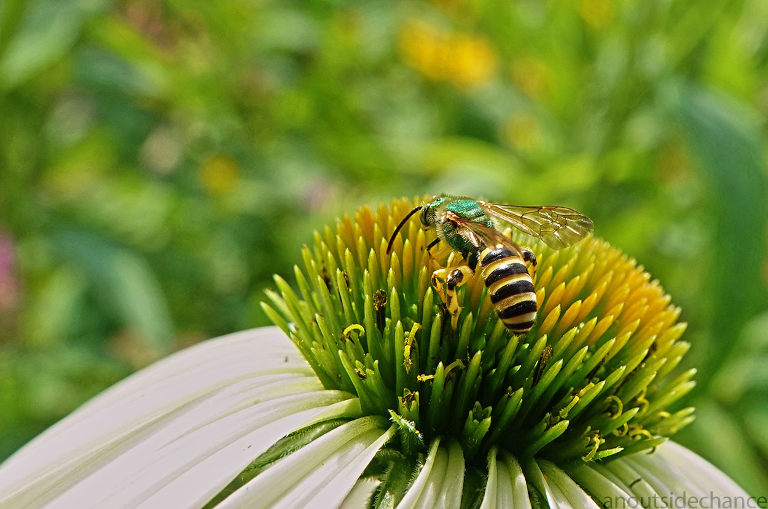It will be several more weeks before bees start visiting flowers in my part of the world. But while I wait for gardens and meadows to come alive again, it’s been a joy to read Stephen Buchmann’s new book What a Bee Knows. (Island Press, March 2023)
Buchmann sets the scene in his opening chapter, describing how a ground-nesting bee cautiously emerges from her nest after looking and listening for possible predators:
“The female bee briefly shivers the powerful flight muscles within her thorax to warm up. Ready, she launches herself skyward and hovers in midair. Performing an aerial pirouette, she flies left, then back to the center, and then to the right of her nest. She repeats these back-and-forth, ever-wider zigzags, all while facing her nest and flying higher with each pass. In fact, she is memorizing the locations of the physical landmarks around her nest. These could be small stones, live or dead plants, bits of wood, or similar debris. She quickly creates a mental map of her home terrain. In less than a minute, she has memorized all the visual imagery, the spatial geometry, and the smells of her immediate surroundings.” (What a Bee Knows: Exploring the Thoughts, Memories, and Personalities of Bees, page 2)
Bees use a wide range of senses to navigate through the world, sometimes in ways we can scarcely imagine. As a pollination ecologist with decades of research experience, Buchmann is an ideal guide to this world, at once both familiar and alien, in our own backyards.
Let’s start with that word “knows”. Buchmann cites his own experience and the work of many other researchers to make the case that bees form, memorize, and use mental maps; they can count; they feel pain; they can react to changes by enacting new plans, even when the plans will not bear fruit for most of a bee’s lifetime; and they can likely pass some cognitive tests that are beyond the ability of dogs and cats. All very impressive, for a group of insects whose tiny brains have hardly changed in structure for a hundred million years.
That brain must manage a range of sensory inputs. A bee’s eyes – far larger, proportionally, than ours – see in three colours, ultraviolet, green and blue. In some respects a bee’s vision is low-resolution, but it provides high-speed imagery which allows a bee to distinguish flowers, and other insects, while zooming through meadows at 20 kilometers/hour or faster.
Honey Bee at Borage flower.
Buchmann writes: “Compared with the size of their heads, bee have immense faceted eyes. Their vision, however, is much coarser than our own; they can recognize the shape of a flower only from a few inches away. Bee color vision is shifted into the ultraviolet (UV) part of the spectrum, but they are blind to red colors. Astonishingly, they can recognized patterns of polarized light across an otherwise uniform blue sky.” (What a Bee Knows, p 47)
Nearly all species of bees are vegans, though they evolved from predatory wasps. These wasps dined on tiny thrips, which tended to come with a tasty dusting of nutritious pollen. Over time, the prevailing theory goes, proto-bees learned to stop chasing thrips and just go straight to flowers for meals of pollen and nectar. Today bees attach a tiny ball of “bee bread” – a mix of nectar and pollen – to each egg, and this supplies all the nutrients a hatching larva needs to develop into an adult flying bee.
Though most flowering plants need bees and/or other pollinators, and bees need flowers, the relationship is complex.
Bee laden with Yellow Salsify pollen.
Buchmann writes: “we need to remember that plants and bees have very different evolutionary goals. Bees must collect pollen and nectar to feed their larvae and themselves. … Flowering plants want to minimize pollen wastage.” (p 77)
Flowers need to ensure someone will carry pollen from one flower to another of the same species. That service comes with costs:
“About 3 percent of a flowering plant’s total energy budget is invested in the production of nectar. Pollen, floral oils, resins, and floral scent molecules are even more costly for plants to produce in their strategies for attracting, keeping, and rewarding pollinating bees.” (p 86)
Bees will happily move from flower to flower, picking up and losing pollen along the way. But if a bee takes pollen from a salsify flower, visits a fleabane next, then goes to a dandelion, not many of the pollen grains will make it to the right blossoms to fertilize those flowers. From a flower’s point of view, it’s important that a bee visits mostly flowers of one species on a given day.
Bumblebee on catnip.
Buchmann writes: “[Researchers found that] bumblebees had an intermediate level of floral constancy. Bumblebees are considered to be less faithful foragers than honey bees.” (p 137)
Richly attractive scents help flowers keep bees coming back. But how does the bee detect that scent? More to the point, where is a bee’s nose? Buchmann tells us:
“The honey bee’s paired antennae are her nose. Both antennae are covered with thousands of sensory hairs, most of which respond to airborne odors. … Bees’ antennae … provide directional information. Think of smelling in stereo. Their antennae can move independently; therefore, unlike us with our fixed noses, bees can get a three-dimensional impression of an odor field.” (p 59-60)
But if flowers smell so good they keep bees coming back to their species, and only their species, that brings up another problem for bees to solve. How can a bee ensure, before she zooms in for a landing, that another bee hasn’t recently made off with all the pollen?
The answer may be that bees, which pick up a positive electrostatic charge while flying, are able to sense changes in the electrostatic charges of flowers – allowing them to sense which flowers have been recently visited.
Honey Bee on Aster.
Buchmann writes: “Plants typically bear flowers at or near their growing tips, and these tips develop the strongest negative charges over an entire plant’s surface. Positively charged flying bumblebees and likely other bees can detect the negative charges on flower surfaces. Across their petals, stamens, and styles, flowers possess fine patterns of differing electrostatic charges.” (p 68)
What a Bee Knows is stuffed with fascinating information. Why does a male bee (drone) have no father, though he does have a grandfather? (It’s because a queen bee lays some fertilized eggs and some unfertilized eggs. All male bees are born from the unfertilized eggs, while all female bees, including queens, are born from fertilized eggs.)
 How do honey bees make precisely-engineered, energy- and material-efficient honeycomb cells from beeswax? (Partly through careful teamwork in producing, chewing, and depositing tiny flakes of wax – and partly through the emergent, self-organizing physical properties of beeswax when it is heated to a range of 37°–40°C.)
How do honey bees make precisely-engineered, energy- and material-efficient honeycomb cells from beeswax? (Partly through careful teamwork in producing, chewing, and depositing tiny flakes of wax – and partly through the emergent, self-organizing physical properties of beeswax when it is heated to a range of 37°–40°C.)
We might guess that for a scientist with a career in bee research, one of the most satisfying recurring phrases in the book is “we don’t know” – many mysteries remain for bee students to explore. I wish, though, that the book were not so wholly reliant solely on the western scientific tradition, or at least that it had clearly acknowledged that many peoples around the world have likely known things about bees long before any western-trained scientist “discovered” these things. Indeed, much knowledge about bees has likely vanished in recent centuries, along with the traditions and languages of many human cultures.
One other question kept coming to my mind as I read through the book: what about the widely-reported problem of diminishing pollinator populations, which I can see even in my own back yard? As Buchmann reveals in the Epilogue, he too has been concerned about this problem – for decades. In 1996 he co-authored a book entitled The Forgotten Pollinators, and in past twenty-seven years, “unfortunately, things have only gotten worse for pollinators.” (p 211)
For 100 million years, bees and their relatives have made the most of their marvelously capable sensory organs, and a relatively simple, efficient brain. They have adapted to changes in ecosystems while also engineering changes in those ecosystems.
The great majority of flowering plants, including those responsible for most human food, depend on bees and other pollinators – but by our actions we are rapidly killing them off.
As Buchmann puts it, “It’s simple: we need bees more than they need us.”
Will some species of bees find ways to survive, either in spite of us or after we are gone? Will we humans carry on with the practices that are driving so many species towards extinction, thereby promoting, also, our own extinction? The answer to those questions, too, is simple.
We don’t know.
Photos used for this review taken by Bart Hawkins Kreps in Port Darlington, Ontario. Image at top of page: Green Metallic Sweat Bee on Echinacea flower (full-screen image here).










